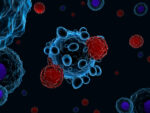Understanding blood work from a CAD patient’s perspective
I've learned that the different values indicate disease progression or remission
Written by |

The nurse had taken all of my vitals, and the doctors had come in for a chat. My checkup was almost over: yay! But the part I hate most — the blood draw — was next. I hoped the nurse was in a good mood, as I’m convinced it makes a difference.
We’ve all heard the phrase, “This may sting a bit.” No, it does not. It hurts, plain and simple. Because my veins often don’t cooperate, it has to be done more than once during an appointment. I’ve heard it all: “Your vein rolled,” or, “The vein collapsed.” I’ve even been told my vein “couldn’t be found.”
I have such a strong visceral reaction to this part that I can’t watch what’s happening. I always tightly shut my eyes, turn my head away, and try to imagine I’m snorkeling at my favorite beach — any method to block my consciousness of the invasion that’s about to happen.
This year was an entirely different experience. I didn’t watch, but the nurse found the vein quickly and it didn’t hurt at all. I’m still amazed.
I visit a hematologist regularly because I have cold agglutinin disease (CAD), which entails frequent blood work. The frequency varies from person to person and disease activity at any given time. I had weekly blood work done when I was being treated with Rituxan (rituximab), and I have annual blood work when I’ve been in the tropics. Nonetheless, the type of these tests basically remains the same.
In understanding why these tests matter, here’s what I’ve learned about CAD blood work: The different values indicate the progression or remission of the disease. The following is simply an opinion I’ve developed after reading about CAD in recent years. It’s an attempt to answer a reader’s query. Please don’t take this as medical advice. I have a degree in music, not medicine. Always consult your healthcare team with any specific questions or concerns.
Key results I monitor
The initial blood work tests look for values of different components of blood and may include a complete blood count test, a Coombs test, a cold agglutinin titer test, a thermal amplitude test, a lactate dehydrogenase test, a bilirubin test, an alanine aminotransferase test, and an aspartate aminotransferase test. Reticulocytes are also checked because they are brand-new red blood cells and show how well bone marrow is compensating for hemolysis, the destruction of red blood cells.
After I was diagnosed with CAD in 2018, I familiarized myself with many of these tests, along with their interpretations. Having said that, I recognize that my interpretation isn’t always reliable, which is why it’s important to wait for the medical team to explain test results. Certain values, though, have caught my attention.
I’m curious about my hemoglobin and just how anemic I am. This is because I’m always tired. The results of a hemoglobin test tell me there’s a reason why I’m tired.
The second value I look for is my immunoglobulin M (IgM), a type of antibody the immune system produces to help fight infections. It’s the antibody that destroys the agglutinated red blood cells caused by CAD. The desired IgM level is between 40 milligrams per deciliter (mg/dL) and 230 mg/dL. In June, mine topped out at 1,500 mg/dL.
The final value I look at is bilirubin, which is a yellow pigment produced during the breakdown of red blood cells in the liver, spleen, and bone marrow. If I were experiencing hemolysis, there might be a slight yellowing of my eyeballs beneath my lower lids. It may also show around my fingernails, revealing that my liver is working harder.
Reflections on the wonder of the human body
After the appointment I described above, my doctor called me. At that time, I hadn’t seen my blood work yet. I was aware of the symptoms my body had experienced all spring, so it didn’t surprise me when he said that further tests were needed. The next day, I was able to read the results online.
I try not to needlessly worry when I read the results of my lab work. If I have a question, I can call my medical team and ask. There are so many things that need to be balanced and evaluated together. All of these different components fill me with awe. I keep in mind Psalms 139, which states, “I am fearfully and wonderfully made,” and, “My frame was … intricately woven.” The older I am, the more I realize how true that is.
Note: Cold Agglutinin Disease News is strictly a news and information website about the disease. It does not provide medical advice, diagnosis, or treatment. This content is not intended to be a substitute for professional medical advice, diagnosis, or treatment. Always seek the advice of your physician or other qualified health provider with any questions you may have regarding a medical condition. Never disregard professional medical advice or delay in seeking it because of something you have read on this website. The opinions expressed in this column are not those of Cold Agglutinin Disease News or its parent company, Bionews, and are intended to spark discussion about issues pertaining to cold agglutinin disease.





Leave a comment
Fill in the required fields to post. Your email address will not be published.